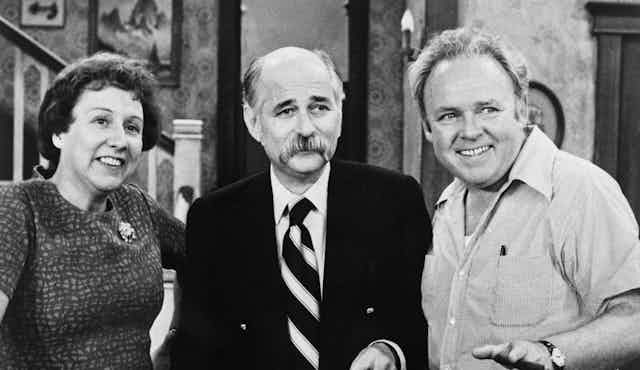Even Americans who strongly disagree with each other may find common ground when they watch the same TV shows and movies, especially those that make us laugh or cry.
Norman Lear, who died on Dec. 5, 2023, at 101, created television shows that did just that.
“All in the Family,” “Sanford and Son” and his other biggest hits began to air in the 1970s, a time when the U.S. desperately needed to bridge divides.
‘All in the Family’
In the late 1960s, the U.S. was in the throes of the Vietnam War and the country was divided on many issues. Many young people were beginning to vehemently protest – and not just against the war. They sought greater equity for people of color and an end to what they perceived as unjust military operations on the other side of the world.
Yet TV, the dominant media of the time, largely portrayed a sanitized version of society, with visions of domestic bliss, a world where few were poor and racial tensions seemed nonexistent.
Lear changed the face of television when he teamed up with fellow producer Bud Yorkin to create “All in the Family.”
The situation comedy, which aired from 1971-79, revolved around Archie Bunker, a working-class conservative unafraid to blurt out his bigotry. It emphasized interactions with his family, particularly Archie’s modern-minded, liberal son-in-law Michael Stivic, portrayed by future director Rob Reiner. The show tackled issues such as racism, sexism and social change, often using humor to address these complex and sensitive topics.
The show’s theme song, sung at the beginning of each episode, was an earworm aptly titled “Those were the Days.” Its lyrics parodied Archie’s stuck-in-the-past mindset: “And you knew who you were then. Girls were girls and men were men.”
“All in the Family” unveiled the hidden conflicts simmering within numerous American families and throughout American society. More than just a sitcom, the show was a reflection of its time and a catalyst for hard conversations about everything from civil rights to menopause.
CBS executives initially worried that the audience wasn’t ready for this kind of truth telling. But viewers enthusiastically embraced the show.
“All in the Family” topped the weekly charts of the most-viewed TV programs for years. Critics loved it too – the show won 22 Emmys, including four for Lear.
New storytelling venues
Today, divisive culture wars are on the rise again. Many Americans pine for a return to supposedly more traditional times.
But show business has changed since “All in the Family” was on the air and some 40 million Americans tuned in to watch.
No single TV show can help bring everyone together now. Instead, a fractured audience chooses from hundreds of TV and streaming channels, gaming platforms and social media sites that often reinforce existing beliefs.
When people consume entertainment and the media, it can isolate rather than unify.
But as a former movie executive who now conducts research about the power of storytelling, I firmly believe that storytelling still can play a unifying role.
My research team has found that members of Generation Z, people born between 1997 and 2012, yearn for storylines that address social issues, such as inequity and bias against marginalized communities, and that mirror their personal lives. These themes, which include their relationships with their parents, are reminiscent of Norman Lear’s work.
Archie Bunker, for example, was modeled on his own father.
Norman Lear’s legacy offers storytellers a road map for meeting the needs of Americans coming of age today. I believe that we need more storytellers who, like Lear, hold up a mirror to our world, showcasing its complexity and imperfections – both the good and the bad.

